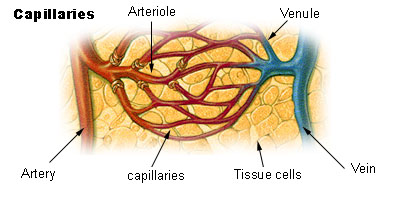Arteriole

Template:WikiDoc Cardiology News Editor-In-Chief: C. Michael Gibson, M.S., M.D. [1]
Overview
An arteriole is a small diameter blood vessel that extends and branches out from an artery and leads to capillaries.
Arterioles have thin muscular walls (usually only one to two layers of smooth muscle) and are the primary site of vascular resistance[1].
This means blood pressure in the arteries supplying the body is a result of the interaction between the cardiac output (the volume of blood the heart is pumping per minute) and the vascular resistance, usually termed total peripheral resistance by physicians and researchers.
Natural fluctuation
The up and down fluctuation of the arterial blood pressure is due to the pulsatile nature of the cardiac output and determined by the interaction of the stroke volume versus the volume and elasticity of the major arteries.
In a healthy vascular system the endothelium, inner lining of arterioles and other blood vessels, is smooth and the vessel is relaxed.
This healthy condition is promoted by the ample production of nitric oxide in the endothelium, which biochemical reaction is regulated by a complex balance of polyphenols, various nitric oxide synthase enzymes and L-arginine. In addition there is direct communication via gap junctions between the endothelial cells and the vascular smooth muscle
Pathology
Any pathogen which constricts blood flow, such as stenosis, will increase total peripheral resistance and lead to hypertension.
Medication
The muscular contraction of arterioles is targeted by drugs that lower blood pressure (antihypertensives), for example the dihydropyridines (nifedipine and nicardipine), which block the calcium conductance in the muscular layer of the arterioles, causing relaxation.
This decreases the resistance to flow into peripheral vascular beds, lowering overall systemic pressure.
Metarterioles
A "metarteriole" is an arteriole which bypasses capillary circulation.[2]
References
- ↑ http://www3.umdnj.edu/histsweb/lab7/lab7arterioles.html
- ↑ Essentials of Human Physiology by Thomas M. Nosek. Section 3/3ch9/s3ch9_2.
da:Arteriole de:Arteriole it:Arteriola lt:Arteriolė nl:Arteriole